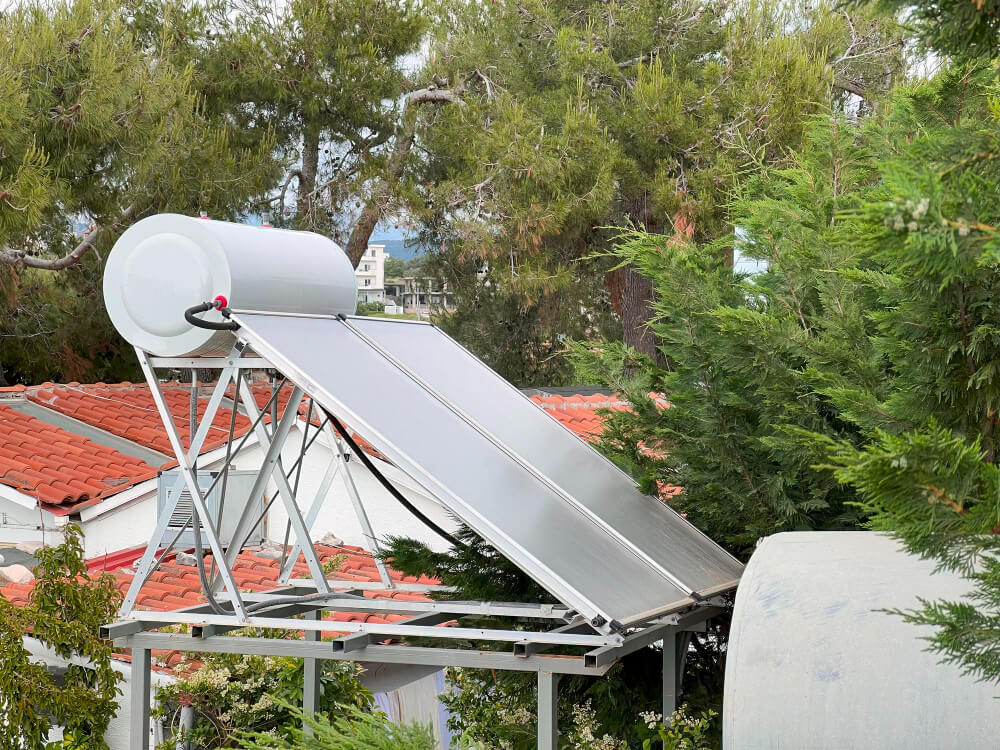
Heating water is one of the biggest energy expenses for Indian households. Instead of relying on electricity or gas geysers, more families are switching to a hot water solar system. It’s eco-friendly, cost-effective, and works well in Indian climates.
This guide explains everything you need to know about hot water solar systems—types, cost, benefits, and installation.
What is a Hot Water Solar System?
A hot water solar system uses sunlight to heat water through solar collectors installed on rooftops. The heated water is stored in insulated tanks for daily use. Unlike electric or gas heaters, these systems rely on renewable energy, making them both eco-friendly and economical.
They are also called solar water heaters and are widely used in homes, hotels, hostels, and hospitals. When combined with Rooftop Solar setups, they provide both electricity and hot water, maximizing savings.
Types of Hot Water Solar Systems
There are two main types of solar water heating systems:
1. Flat Plate Collector (FPC) Systems
- Made with flat absorbers that capture sunlight.
- Durable and works well in high-pressure applications.
- Require more investment compared to other types.
- Best for urban households with continuous hot water needs.
2. Evacuated Tube Collector (ETC) Systems
- Use parallel rows of glass tubes with vacuum insulation.
- Efficient in colder and cloudy regions.
- More cost-effective compared to FPC systems.
- Easy to install and widely available in India.
Both types can be adapted to different budgets and requirements. Exploring Solar PV Modules Types can also help you understand which solar technology suits your home better.
Active vs Passive Systems
- Active Systems: Use pumps and controllers to circulate water. Suitable for larger households and institutions.
- Passive Systems: Rely on natural circulation (thermosyphon). Cheaper, more reliable, but slightly less efficient.
Components of a Hot Water Solar System
- Solar Collectors (FPC or ETC)—absorb sunlight.
- Storage Tanks—insulated tanks that keep water hot for hours.
- Pipes and Valves—circulate water or heat-transfer fluids.
- Backup Heaters—electric or gas heaters for cloudy days.
When calculating the Solar for Home Cost, it’s important to include both solar PV (for electricity) and solar heating systems if you want a complete green energy setup.
Hot Water Solar System Cost in India (2025)
The price of a hot water solar system depends on capacity and type:
- 100 LPD (Litres per day): ₹20,000 – ₹25,000
- 200 LPD: ₹30,000 – ₹40,000
- 300 LPD: ₹45,000 – ₹60,000
- 500 LPD and above: ₹70,000+
👉 A 200 LPD system is ideal for a family of four.
For comparisons, check guides on Solar Panel Cost House, Solar Energy Panels Price, and Price of Solar Panel for Home.
Government Subsidies for Hot Water Solar Systems
The Indian government offers subsidies under MNRE (Ministry of New and Renewable Energy) to encourage solar water heating adoption. Some states provide additional incentives.
Like Solar PV Panels Price in India, these subsidies significantly reduce upfront costs, making solar more affordable for households.
Installation and Maintenance
- Installation: Solar collectors are mounted on the roof at a tilt facing south for maximum sunlight. Pipes connect collectors to storage tanks.
- Maintenance: Minimal—just clean collectors periodically and check for scaling in hard water areas.
- Advanced Tools: Technologies like Drone Thermal Imaging are used by contractors to check system performance and detect leaks or inefficiencies. Top Drone Service Providers in Chandigarh also assist in surveying rooftops for solar setups.
Benefits of Hot Water Solar Systems
- Cost Savings—Reduce electricity bills by 70–90% for water heating.
- Eco-friendly —no greenhouse gas emissions.
- Low Maintenance—Long lifespan with minimal servicing.
- Energy Independence—Depend less on electricity or gas supply.
- Scalability—Available in capacities from 100 LPD to 5,000+ LPD.
When paired with Solar Electric Panel for Home systems, households can achieve full energy self-sufficiency.
FAQs
Q1: How does a hot water solar system work?
A: Collectors capture sunlight, heat water, and store it in insulated tanks for daily use.
Q2: What is the difference between FPC and ETC systems?
A: FPC is more durable and suitable for high pressure, while ETC is cheaper and more efficient in colder regions.
Q3: How long does a solar water heater last?
A: 15–20 years with minimal maintenance.
Q4: Can it work without sunlight?
A: Backup electric or gas heaters are used during cloudy days.
Q5: Does it increase property value?
A: Yes, similar to Solar Panel Suppliers for electricity systems, solar heaters add value to homes.
Q6: Can hotels and industries use hot water solar systems?
A: Yes, large-capacity systems are available for commercial applications.
Q7: How much space is needed?
A: Around 2–3 m² of roof space for a 100 LPD system.
Q8: What is the average payback period?
A: 3–5 years, depending on usage.
Q9: Can hard water damage the system?
A: Yes, scaling may occur, so use systems with corrosion-resistant tanks.
Q10: Who installs these systems?
A: Certified Solar Energy Contractors handle design, installation, and maintenance.
Final Thoughts
A hot water solar system is one of the smartest and most cost-effective investments for Indian homes in 2025. With falling prices, state subsidies, and simple maintenance, it’s easier than ever to switch to solar water heating.
By combining solar water heaters with rooftop solar panels, you can reduce your bills, increase your property value, and contribute to a sustainable future.
